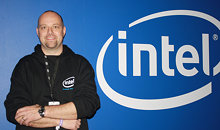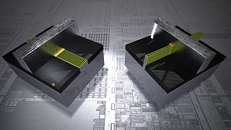qubit
Overclocked quantum bit
- Joined
- Dec 6, 2007
- Messages
- 17,865 (2.80/day)
- Location
- Quantum Well UK
| System Name | Quantumville™ |
|---|---|
| Processor | Intel Core i7-2700K @ 4GHz |
| Motherboard | Asus P8Z68-V PRO/GEN3 |
| Cooling | Noctua NH-D14 |
| Memory | 16GB (2 x 8GB Corsair Vengeance Black DDR3 PC3-12800 C9 1600MHz) |
| Video Card(s) | MSI RTX 2080 SUPER Gaming X Trio |
| Storage | Samsung 850 Pro 256GB | WD Black 4TB | WD Blue 6TB |
| Display(s) | ASUS ROG Strix XG27UQR (4K, 144Hz, G-SYNC compatible) | Asus MG28UQ (4K, 60Hz, FreeSync compatible) |
| Case | Cooler Master HAF 922 |
| Audio Device(s) | Creative Sound Blaster X-Fi Fatal1ty PCIe |
| Power Supply | Corsair AX1600i |
| Mouse | Microsoft Intellimouse Pro - Black Shadow |
| Keyboard | Yes |
| Software | Windows 10 Pro 64-bit |
Nordic Hardware has scored an exclusive interview with Pat Bliemer, Managing Director of Intel Northern Europe to discuss the technology following on from the 22 nm one used in the upcoming Ivy Bridge processors. Unfortunately, Bliemer was light on the technical details of this technology and didn't say when it would see the light of day, except to say that it will make fuller use of the Tri-Gate tech being used in the Ivy Bridge processors and that test circuits are running.


View at TechPowerUp Main Site
Back in July, we looked even further ahead and reported that Intel aims to have 10 nm-based processors by 2018 and that the 14 nm tech is due for release around 2014. Watch this space.We need to keep going and you can trust me that in our labs we actually have the next generation after 22nm running, so we need to keep going.[...]I cannot really disclose more about that other than that in a laboratory-environment, absolutely we do have the path, our engineers do have the path to actually go and produce 14nm products. There are many variables that you can play with of course it is not the right name for it and the engineers would not like it when I say play, that you can influence to actually go and stay to that model. And I think the breakthrough we had now with the 3D metal gates, just the design of the gate will actually allow for much more efficient thermals and power.


View at TechPowerUp Main Site










 Gotta love tech though, eh?
Gotta love tech though, eh? 
